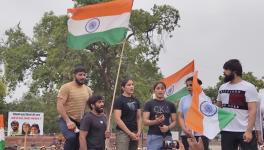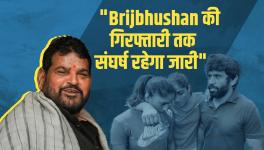Tokyo Olympics: Ravi Dahiya’s Silver, Deepak Punia’s Near Miss and the Lessons for Indian Wrestling
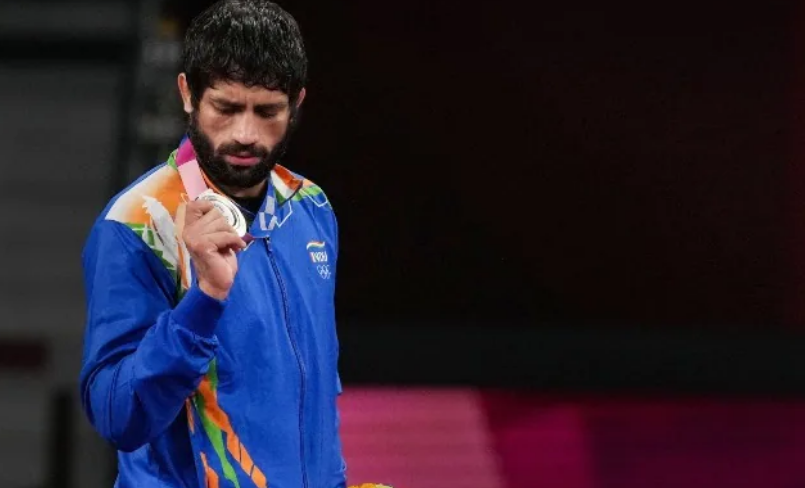
Ravi Kumar Dahiya with his medal after the men’s 57kg freestyle wrestling podium ceremony at the Tokyo Olympics on Thursday. Inside story - Ravi in action vs Uguev; Deepak Punia during his bout against Myles Amine (Pic, Twitter).
It is strange! We saw two of India’s best wrestlers lose in the medal rounds at the Tokyo Olympics within a few minutes on Thursday. Yet, we are inclined to celebrate. We should, surely! The winner-loser dilemma should be pinned down, superseded by achievement. Especially this day.
Ravi Dahiya’s loss came with a silver medal — a momentous achievement for the 23-year-old, equalling the best ever performance by a wrestler at the Olympics for India, and securing the country’s fifth medal in Tokyo.
Also Read | Fearless Attacker Turns Cautious Counter Wrestler: What is Ailing Vinesh Phogat?
Deepak Punia, 22, went down a few minutes after Ravi on the central mat of the Makuhari Messe Hall in the Japanese capital. His loss brings with it a dreaded deafening silence. The 86kg freestyler let the medal slip out of his hands in the final 10 seconds of the bout. This is as close to a Shakespearean tragedy one could get on the wrestling mat. We could see the pain and disbelief in Deepak’s eyes as he conceded the point and the medal. He could easily have been at the Globe Theatre playing King Lear. But he is Deepak, the theatre is a wrestling mat, and he finished fifth.
Two losses…. Which brought out moods that were poles apart, while also giving us a valid reason to celebrate. We Indians are indeed the half-glass-full kind, aren’t we, though at the Games, our glass has been more empty than we would like to perceive and accept.
The contrast does not end in the abstract caricature the mood and feel presents. There were many absolutes in the losses, ones which should be taken as lessons by Indian wrestling for the future. The immediate future as well... As close in the universal timeline as tomorrow, when Bajrang Punia, a medal contender struts out in the 65 kg division.
For Ravi, it was a Russian masterclass that shows where he should aspire to be in three years’ time. He should be in Paris, he should be on the podium again in 2024. But on what rung and how? The summit bout against Zavur Uguev of the Russia Olympic Committee (ROC) is layered enough to provide Ravi with not just a roadmap, but also a detailed report of why he went down 7-4, though it was not a tame submission to what was as good as predestined.
For Deepak, the increments needed are much more complex than Ravi. It is clear he is way off medal credentials though he lost bronze by a whisker. That had more to do with a kinder draw. That apart, Deepak, or Anshu Malik in the repechage round earlier in the day, lost because Indian wrestling is yet to wake up to a small yet significant tactical variation the bigger nations in the sport have brought in for the tight bouts of Tokyo.
Also Read | Indian Hockey Team Sheds Historic Burden, Beats Germany to Win Bronze at Tokyo Olympics
It seems, wrestling has borrowed something from basketball. The NBA to be exact. Wrestlers, the winners in Tokyo, have perfected the clutch shot, or rather the clutch takedown, and Deepak went down to it, as did Anshu earlier in the day. They were not the only wrestlers who were at the receiving end. Many others were caught unawares in the dying seconds of the bout.
The set of variables within wrestling is uniform for all. Just that it gets updated every four years. An Olympic cycle, the four years (this time it was five) between two successive Games, is the period when the contenders of world wrestling — the top nations — draw up quite novel strategies, tactics and even variations or combinations of techniques that would end up having a say in the business-end bouts. And by default, they become the tried-and-tested formula for the stragglers in subsequent years. Till the envelope is pushed at the next Games.
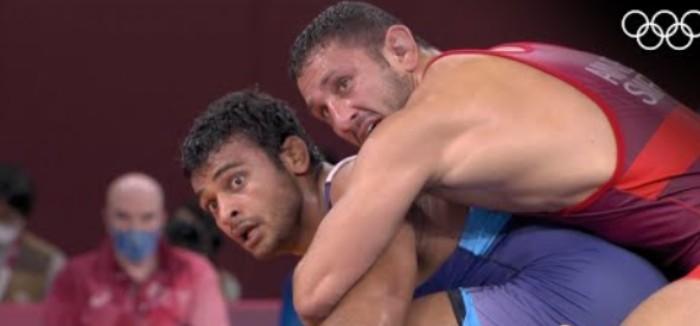
This year, one of the most significant and impactful changes was seen in the evolution of bout management. Working within parameters set by the passivity rules, wrestlers have learnt to leave things pretty late in the bout. So late that the grappler who is winning would have already seen images of the medal around his neck. Snap. The next image would be the seconds clock on the scoreboard ticking away, with the opponent in the lead. Ask Deepak and he would attest to this. This even happened to the great Hassan Yazdani Charati of Iran in the final of Deepak’s category. He was taken down in the last 10 seconds by David Taylor of the USA, winning the bout and his first Olympic gold by a single point.
So, the effectiveness of this… Well the tactic is so new that one is not sure if they have even coined a name for it. Let us call it the clutch takedown. Its effectiveness is beyond doubt. It has earned shock victories, surprise wins, magical turnarounds — listing out the adjectives used by the commentators describing the end result of this tactic is a long process in itself and that is testament to its impact this time around.
Also Read | Hurdling to Greatness: Karsten Warholm Frees an Event From the Matrix
Leaving it late requires many things as a prerequisite. Firstly, you need to be sure of the technique you would apply to get that clutch point. Now that is not as easy as perfecting it in the training hall. It also needs to be suited to overcome the defenses of the opponent. So, it is paramount that a wrestler needs at least two or three clutch takedown techniques offering him choice based on the defensive tendencies of his opponent.
The rest depends on how you adjust all the variables in the grappling exchanges building towards it. That is the real art. It is either by creating a lull and sudden change of pace, or by stepping up the tempo and then forcing it out. The smokescreens vary, but the end result remains the same. What a shock!
Deepak was shocked beyond belief. However, Deepak’s loss against Myles Amine of San Marino in the bronze play-off also came about because he made a critical mistake in his reaction to the clutch takedown attempt. No doubt induced because of the lull Amine created. The San Marino wrestler was hardly rushed or diving in blindly.
That is where Deepak’s inexperience in bout management showed. He was fighting a wrestler who is a top contender in NCAA championships in the US. Amine understands clutch fighting. That is how bouts are won in the most competitive collegiate wrestling tournament in the world. When the takedown was being employed, and at the moment Deepak was losing it, the easiest thing he could have done was to step out and concede a single point instead of two. That single point would have tied the scores at 2-2, and Deepak would have won on countback of the highest technical point earned. It was a split-second decision. One that wrestlers at the Olympic level should be adept at making. Deepak did not, and that is another lesson for the young Indian champion.
Also Read | Lovlina Borgohain Settles for Bronze, But Not Before an Epic Fight Against Odds
Clutch fighting will be a factor for Bajrang as well — the last wrestler in the fray for India. He has been consistently featuring in the medal rounds in global tournaments. He is a former World No. 1 too. He is elite. However, he also has to deal with wrestlers who are masters at eking out results from near impossible bouts. It remains to be seen whether Bajrang, the most accomplished Indian wrestler of this generation, has worked on the tactical department to add the part which would help him get those 2-1, or 3-2 type results. The scoreline which invariably follows in finals.
Unless you are Uguev that is, and you are facing an Indian champion who is yet to be seasoned for gold medal bouts. Ravi is, no doubt, good. However, Ravi is still someone who we would describe as one for the future, provided he develops from where he is now. That he has won an Olympic silver despite being work in progress is testament to his quality.
Of course, he needs to work toward it too, toward greatness. There is always a chance that he would be a one-Games wonder despite having age on his side. We would want him to continue, and blossom into what we can truly describe as a world beater. He has what it takes, and he showed some of it in the final too.
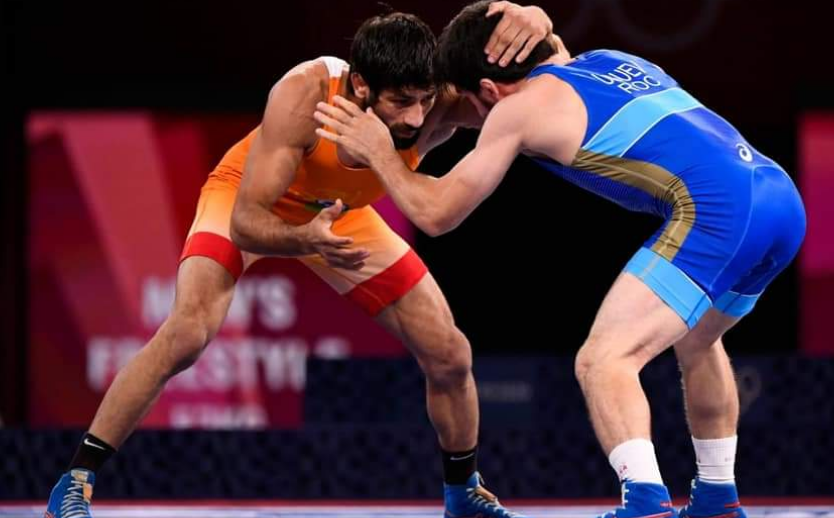
The takedown to tie it 2-2 after the ROC wrestler had taken a two-point lead with pushouts early in the bout, for instance. The Indian’s resolute defense was another highlight. But the gulf in quality between the Russian and Ravi was apparent too.
Also Read | Lightning and the Backhand Swish: An Ode to Tai Tzu-ying and Yufei Chen
Uguev’s takedown move was science and art in harmonic motion. One of the takedowns, a double leg to make it 7-2 was indeed a piece of biomechanical perfection. He changed the plane of his centre of gravity to a lower level using a parallel stance instead of the usual one one leg in the front approach. And then he ducked really low when Ravi pushed, using the Indian’s momentum to get under the tipping point of his mass. And he just eased Ravi onto the mat. It was so smooth that it felt effortless. Well there was force involved. But the predominant factor at play was the physics in the move rather than the leg, shoulder, core and arm muscles of Uguev.
In contrast, Ravi’s takedown was proper working class. Hard labour, using all the might he could conjure up. It was effective only once too. His subsequent attempts were thwarted by Uguev, once by a semi-circular, lock-breaking move hugging the mat, and the other by using the upper body for leverage.
The technical refinement in Uguev, and the advantage it brought out, was evident. We could see that the Indian could match the Russian in the power department. What Ravi needs now is the kind of perfection Uguev has brought into technical repertoire.
An Olympic silver is quite an achievement in Indian wrestling. We can imagine the adulation that awaits Ravi, who already has a larger-than-life legend around him. The key for him would be to look beyond the fireworks. It is clear that Ravi is level-headed much beyond his age. Now he should be honest enough to tell himself that he needs to be better, when all around he will only hear praise. That is his challenge.
Click | For More Coverage of the Tokyo Olympics From Newsclick Sports
Meanwhile, Indian wrestling’s challenge, as always, would be introspection, and planning for the future. While India won a silver, and there is a possibility of another medal via Bajrang, it is easy to forget that we saw two genuine contenders lose out. There are reasons for that, the primary being not paying attention to finer details — be it in preparation, or in inculcating tactical nous. For that, the stakeholders in Indian wrestling have to be hooked to the larger avante garde evolutionary process happening in the game. Till that happens, Indian wrestling will always be playing catch up, with some making it — a silver lining here, and a bronze sheen there. While many fall short by a whisker.
Get the latest reports & analysis with people's perspective on Protests, movements & deep analytical videos, discussions of the current affairs in your Telegram app. Subscribe to NewsClick's Telegram channel & get Real-Time updates on stories, as they get published on our website.










